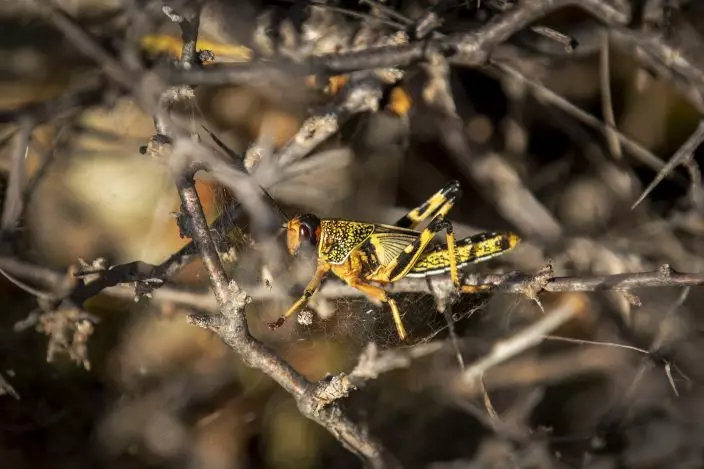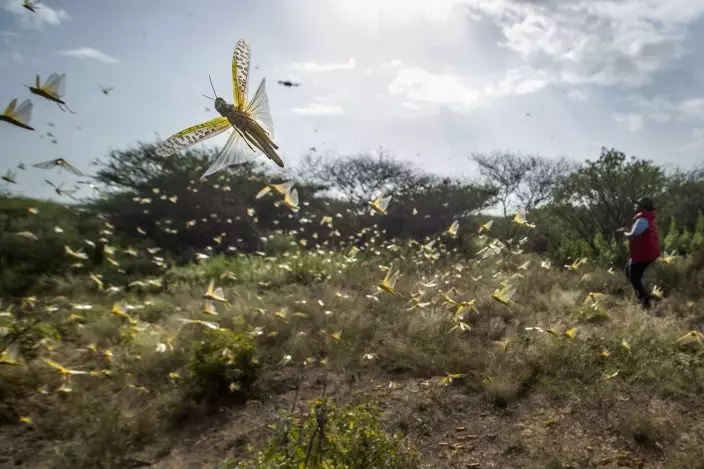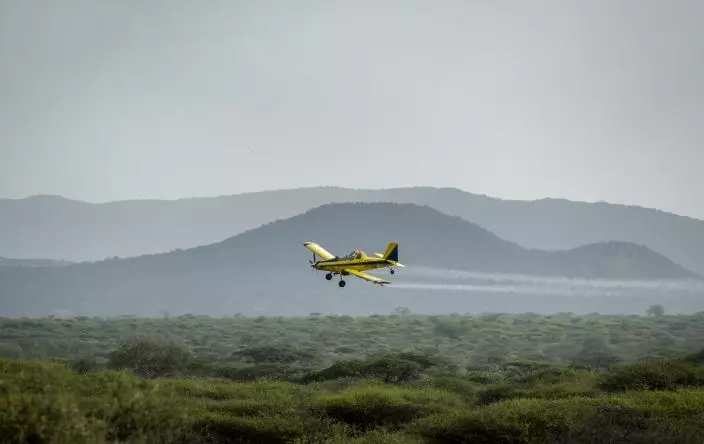The worst locust outbreak that parts of East Africa have seen in 70 years has reached South Sudan, a country where roughly half the population already faces hunger after years of civil war, officials announced Tuesday.
Around 2,000 locusts were spotted inside the country, Agriculture Minister Onyoti Adigo told reporters. The country will try to control the outbreak, he added.
The locusts have been seen in Eastern Equatoria state near the borders with Ethiopia, Kenya and Uganda. All have been affected by the outbreak that has been influenced by the changing climate in the region.

In this photo taken Tuesday, Feb. 4, 2020, a young desert locust that has not yet grown wings is stuck in a spider's web on a thorny bush in the desert near Garowe, in the semi-autonomous Puntland region of Somalia. The desert locusts in this arid patch of northern Somalia look less ominous than the billion-member swarms infesting East Africa, but the hopping young locusts are the next wave in the outbreak that threatens more than 10 million people across the region with a severe hunger crisis. (AP PhotoBen Curtis)
The soil in Eastern Equatoria has a sandy nature that allows the locusts to lay eggs easily, said Meshack Malo, country representative with the U.N. Food and Agriculture Organization.
At this stage “if we are not able to deal with them ... it will be a problem,” he said.
The locusts have traveled in swarms the size of major cities. Experts say their only effective control is aerial spraying with pesticides, but U.N. and local authorities have said more aircraft and pesticides are required. The U.N. has said $76 million is needed immediately.

In this photo taken Saturday, Feb. 1, 2020, desert locusts jump up from the ground and fly away as a cameraman walks past, in Nasuulu Conservancy, northern Kenya. As locusts by the billions descend on parts of Kenya in the worst outbreak in 70 years, small planes are flying low over affected areas to spray pesticides in what experts call the only effective control. (AP PhotoBen Curtis)
U.S. Secretary of State Mike Pompeo on Tuesday during a visit to Ethiopia said the U.S. would donate another $8 million to the effort. That follows an earlier $800,000.
The number of locusts could grow up to 500 times by June, when drier weather begins, experts have said. Until then, the fear is that more rains in the coming weeks will bring fresh vegetation to feed a new generation of the voracious insects.
South Sudanese ministers called for a collective regional response to the outbreak that threatens to devastate crops and pasturage.

In this photo taken Saturday, Feb. 1, 2020, ranger Gabriel Lesoipa is surrounded by desert locusts as he and a ground team relay the coordinates of the swarm to a plane spraying pesticides, in Nasuulu Conservancy, northern Kenya. As locusts by the billions descend on parts of Kenya in the worst outbreak in 70 years, small planes are flying low over affected areas to spray pesticides in what experts call the only effective control. (AP PhotoBen Curtis)

In this photo taken Saturday, Feb. 1, 2020, a plane spraying pesticides flies over a swarm of desert locusts in Nasuulu Conservancy, northern Kenya. As locusts by the billions descend on parts of Kenya in the worst outbreak in 70 years, authorities are flying low over affected areas in small planes and spraying pesticides in what experts call the only effective control. (AP PhotoBen Curtis)


